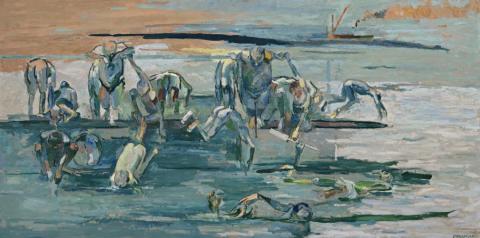THE BATHERS, 1951
JOHN PASSMORE
oil on composition board
91.0 x 183.0 cm
signed and dated lower right: J PASSMORE 51
Macquarie Galleries, Sydney c.1951
Private collection, Melbourne
Thence by descent, private collection, Melbourne
Probably John Passmore, Macquarie Galleries, Sydney, 20 November - 3 December 1951
When John Passmore held his solo exhibition at the Macquarie Galleries, Sydney, in 1951, the art critic for The Sydney Morning Herald hailed it as 'magnificent'.1 Phrases such as 'considerable accomplishments' and 'remarkable power' highlighted the review, describing him as 'one of our best painters, and as a draughtsman unsurpassed.' The Bathers, 1951, one of the most ambitious, largest and successful works of the era, is a classic example of Passmore working in this genre. The waters of Sydney and later Newcastle were the source of his paintings, of people, swimmers, fishing, sunlight and sea, as seen in such related paintings as The Argument, 1953, The Fish Stealer, 1954, and the masterly visual counterpoint of the vernacular, If you don't believe me, ask the old bloke, 1954, all in the collection of the Art Gallery of New South Wales. The company is exulted and The Bathers is rightly placed among them, engagingly fluid, (perhaps 'floating' or 'watery' are more apposite) in its painterly execution.
In this and related paintings, figures are dispersed across the painted field, in groups or single, harmoniously contrasting the occupied with the empty spaces. There is a marvellous dichotomy of line and form, surfaces are fractured, and a wonderful feeling of light adds vibrancy to colour and form.
Passmore returned to Australia from England in 1951 and began teaching at the Julian Ashton School. Numerous paintings based on the subject of bathers surround that date, with examples in the collections of the art galleries of South Australia and Western Australia. The aesthetic and subject references to Cézanne are obvious, but not overwhelming. While Passmore's interest in abstract art led him to participate in the John Olsen inspired 1956 exhibition Direction1 and its manifesto for abstract art, it was not an abiding interest. Even in the face of the evidence of such impressive abstract paintings as Shag on Scratch, c.1959, (Joseph Brown Collection, National Gallery of Victoria) and Jumping Horse-Mackerel, 1959, (Art Gallery of New South Wales), figuration was the anchor of his art.
1. 'Magnificent Work by John Passmore', Sydney Morning Herald, 22 November 1951, p.2
DAVID THOMAS
